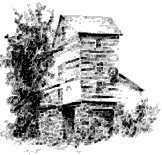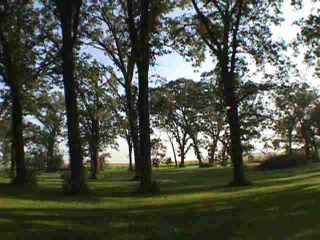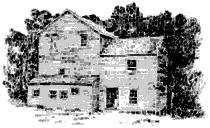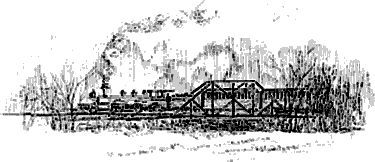
(Click on Text to See Actual Photo of the Rock Valley Mill)

(Click on Text to See Actual Photo of the Rock Valley Mill)
The inspiring history of the property, known today as Shady Oaks, goes back to the Treaty of 1842 when the Sac and Fox Indian tribes ceded their beloved Iowa land to the United States Government. The treaty opened up the land for settlement which is now Marshall County. This period during the Nineteenth Century was known as the Fabulous Forties. Gold was discovered in California, and Easterners were migrating west. The railroad and telegraph were beginning to link the nation together.
Early trappers and hunters had blazed the trails along the rivers and streams in quest of furbearing animals and game. The wagon trail that led past Shady Oaks was one of the first roads in the area. Nearby, a dim wagon trail extended south to the Skunk River. Another wagon trail, along the south side of the Iowa River, could be traced to settlements west of Iowa City.
Many of the first settlers who came to Iowa were from states where woodland farms were prevalent. If a family came from a wooded area, they typically relocated close to streams and timber. In 1848, a small number of people erected their cabins in the grove along Timber Creek. It was here that the area known as Rock Valley was established because of its beauty and timber.
The grove of burr oak trees found at Shady Oaks
was a part of 5,000 acres of the best timber in Marshall County. Word
of mouth identified the area which later became Shady Oaks as a
natural and attractive location for settlers to circle the wagons and
camp. Settlers found an abundant supply of food such as wild turkeys,
geese, ducks, prairie chicken, grouse, and quail. Timber Creek was
full of pike and pickerel.

(Click on Text to Go to the Historical Grove of Oaks Home Page)
On March 18, 1848, John Fletcher Campbell staked his claim to the area of land which Shady Oaks was the integral part. Later that fall with his partner, William Asher, he built the Rock Valley Grist Mill on part of his property near Shady Oaks. It was the first beneficial mill and probably the first public building in Marshall County. Due to his efforts, pioneers were able to make the Rock Valley area their home on a permanent basis. Shady Oaks, provided a vital supporting role in the survival of the settlers. Long trips by wagon had to be made to grind the grain into coarse meal, as it was the only alternative to doing it by hand. The campground served as a home away from home for those coming to the mill to grind grain, buy supplies from its store, and vote.

(Click on Text to See Actual Photo of the Rock Valley Mill)
In May of 1850, Indians plundered John Campbell's claim. The Musquakas drove off his cattle, killed his hogs and made threats. Young Samuel Davison, and a few other settlers retaliated by destroying much of the Indians' corn crop and burning their wigwams while they were away on a hunting expedition. It was directly due to this incident at what is now Shady Oaks that bloodshed nearly came to Marshall County and a fort was constructed for the safety of the settlers. The Dragoons were called for protection, but thanks to the efforts of John Campbell and others, peace with the Indians had already been renewed. Campbell, and the other heroes of Fort Robinson, then returned to their homes.

Rock Valley School and Meeting House
(Click on Text to See Actual Photo of the Rock Valley School)
In 1852, the first Methodist Mission in Marshall County was established in the Rock Valley Mill. While attending Methodist revival camp meetings, which were typical of the day, pioneers stayed at the Shady Oaks site. Multiple pulpits were erected on the property. Methodists from near and far met in prayer and praise. Recognized as the center of the Rock Valley community, a school was then constructed on the same foundation as where the Shady Oaks Lodge/Office still stands today. The school was also used for worship, and early-day circuit ministers preached there. Rock Valley School was located on that site from approximately 1852 until it was moved further up the road in 1885.

M and St. L Railroad Crossing Timber Creek Near Rock Valley
(Click on Text to See Actual Photo of the Rock Valley Bridge over Timber Creek)